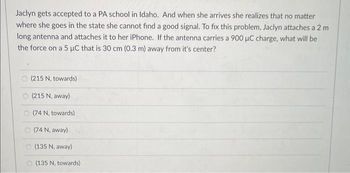Question

Transcribed Image Text:Jaclyn gets accepted to a PA school in Idaho. And when she arrives she realizes that no matter
where she goes in the state she cannot find a good signal. To fix this problem, Jaclyn attaches a 2 m
long antenna and attaches it to her iPhone. If the antenna carries a 900 µμC charge, what will be
the force on a 5 µC that is 30 cm (0.3 m) away from it's center?
(215 N, towards)
(215 N, away)
(74 N, towards)
(74 N, away)
(135 N, away)
(135 N, towards)
Expert Solution
This question has been solved!
Explore an expertly crafted, step-by-step solution for a thorough understanding of key concepts.
This is a popular solution
Trending nowThis is a popular solution!
Step by stepSolved in 3 steps with 2 images

Knowledge Booster
Similar questions
- QUESTION 32 In a version of Millikan's experiment, an oil droplet is released and when it has travelled a distance d1, the electric field is switched on with a magnitude such that at distance dɔ the droplet velocity has been reduced to zero. Calculate the charge on the droplet. Give you answer in equivalent charge of how many electrons. Distance d1: 0.07 m Distance between plates: 0 1 m Distance d2 - d1: 0.012m mass of droplet 3.65x10 16 Kg Voltage difference: 332.1037138 10 'n 本 Click Save amd Submit to save and submit. Click Save All Answers to save all answers. 6°C Clou O1arrow_forwardCurrent Attempt in Progress In the operating room, anesthesiologists use mass spectrometers to monitor the respiratory gases of patients undergoing surgery. One gas that is often monitored is the anesthetic isoflurane (molecular mass = 3.06 x 10-25 kg). In a spectrometer, a single ionized molecule of isoflurane (charge = + e) moves at a speed of 7.82 x 103 m/s on a circular path that has a radius of 0.137 m. What is the magnitude of the magnetic field that the spectrometer uses? Number i Unitsarrow_forwardThe intensity of the radiation that you receive in your tanning bed is 9.87 W/m2. What is the maximum electric field? Please give your answer in Volts per meter.arrow_forward
- A 4.3-MeV (kinetic energy) proton enters a 0.21-T field, in a plane perpendicular to the field. What is the radius of its path?arrow_forwardThe top of the atmosphere is at about 400 kV with respect to the surface of the earth, corresponding to an electric field that decreases with altitude. Near the surface of the earth, the field is about 100 Vm-1 Why then do we not get an electric shock as we step out of our house into the open? (Assume the house to be a steel cage so there is no field inside!)arrow_forwardA carbon-14 ion with a charge of +6.408x10^-19 C and a mass of 2.34x10^-26 kg is sent through a mass spectrometer and hits a detector at a point 10.0 cm to the left of where the beam leaves the velocity selector. The velocity selector and the detector are both in a region of magentic field of strength 0.500 T. If a carbon-12 ion (q=+6.408x10^-19 C, m= 1.99x10^-26 kg) is accelerated to the same velocity as the carbon-14 ion, where would you need to place the detector to detect it? Please also explain and show the steps you used to get there/the physics behind why/how you got to the answer to help me better understand. Thank you soo much. Also, the work and the explanation or most important because I already have the correct answer - I'm just unsure of how to get there.arrow_forward
- The Russian physicist P. A. C˘ erenkov discovered that a charged particle traveling in a solid with a speed exceeding the speed of light in that material radiates electromagnetic radiation. (This is analogous to the sonic boom produced by an aircraft moving faster than the speed of sound in air; see Section 16.9. C˘ erenkov shared the 1958 Nobel Prize for this discovery.) What is the minimum kinetic energy (in electron volts) that an electron must have while traveling inside a slab of crown glass (n = 1.52) in order to create this C˘ erenkov radiation?arrow_forwardSee attached imagearrow_forwardT electrical force between two uranium nuclei placed a distance of 1.81 x 10^-12 m apart from one another? 0.952 N 0.298 N 0.595 N 0.833 N So here goes What is the magnitude of thearrow_forward
- Two neutral, square, thin copper plates (15 cm per side) are situated parallel to each other and located 6 mm apart. A 9V battery is connected to the plates, such that the anode is connected to one plate and the cathode to the other plate, and the battery and plates reach a new electrostatic equilibrium. What is the magnitude and direction of the electric field between the two plates? Two neutral, square, thin copper plates (15 cm per side) are situated parallel to each other and located 6 mm apart. A 9V potential difference is applied across the two plates. What is the electric potential at a distance of 2 mm away from the negatively charged plate (define the negative plate to be at zero potential)?arrow_forwardAn electron of mass me = 9.11 × 10-³1 kg and a charge of - qe = -1.60 × 10-1⁹ C is released, from rest, in a region of uniform electric field that points to the right with a magnitude of |E| =5.55 N/C . How long does it take for the electron to reach a speed of 5.86 x 104 m/s? Assume the experiment is performed in a vacuum and that you can ignore the effects of gravity and friction. Give you answer in units of seconds. Please enter a numerical answer below. Accepted formats are numbers or "e" based scientific notation e.g. 0.23, -2, 1e6, 5.23e-8 Enter answer here secondsarrow_forwardWhat is the electric field at a distance r from an infinitely long charged wire having charge per unit length A. E=N/2TeOr E=N/2TeOr E=N/4TTEOr E=N/2TT€0arrow_forward
arrow_back_ios
SEE MORE QUESTIONS
arrow_forward_ios